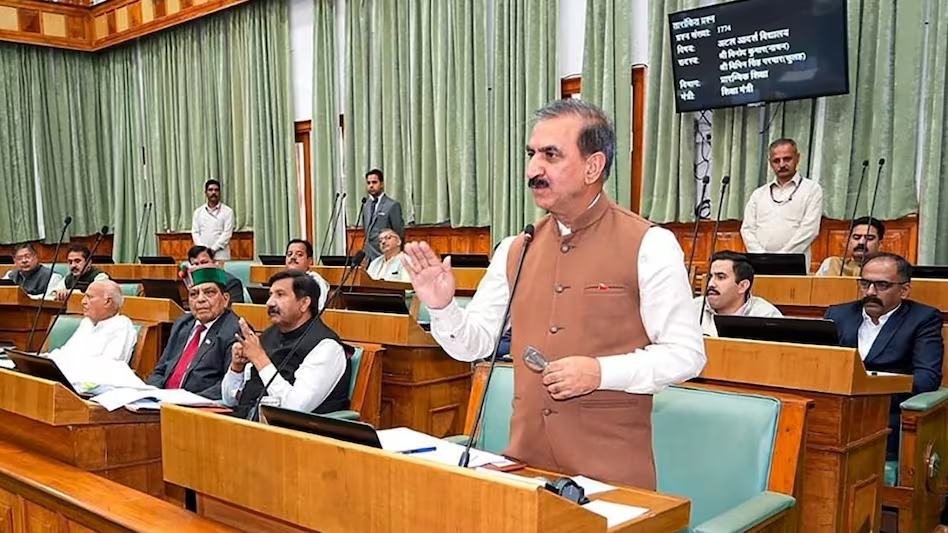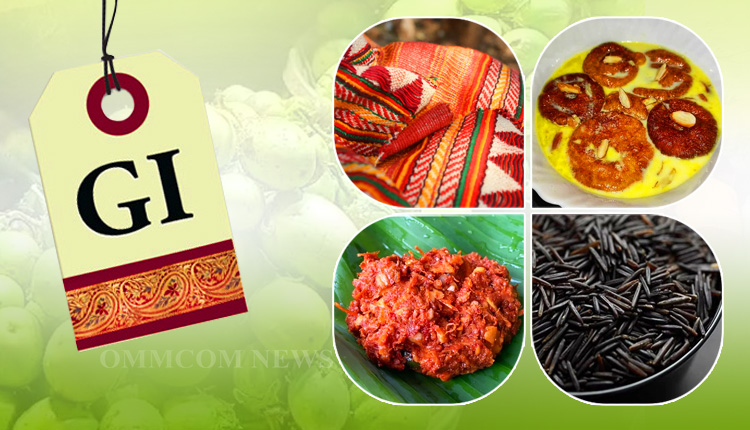- Courses
- GS Full Course 1 Year
- GS Full Course 2 Year
- GS Full Course 3 Year
- GS Full Course Till Selection
- Answer Alpha: Mains 2025 Mentorship
- MEP (Mains Enrichment Programme) Data, Facts
- Essay Target – 150+ Marks
- Online Program
- GS Recorded Course
- Polity
- Geography
- Economy
- Ancient, Medieval and Art & Culture AMAC
- Modern India, Post Independence & World History
- Environment
- Governance
- Science & Technology
- International Relations and Internal Security
- Disaster Management
- Ethics
- NCERT Current Affairs
- Indian Society and Social Issue
- NCERT- Science and Technology
- NCERT - Geography
- NCERT - Ancient History
- NCERT- World History
- NCERT Modern History
- CSAT
- 5 LAYERED ARJUNA Mentorship
- Public Administration Optional
- ABOUT US
- OUR TOPPERS
- TEST SERIES
- FREE STUDY MATERIAL
- VIDEOS
- CONTACT US
PLACES IN NEWS 04 DECEMBER 2024
PLACES IN NEWS 04 DECEMBER 2024
04-12-2024
Tunisia
Why in news?
- Tunisia's olive oil sector is undergoing significant reform under President Kais Saied, addressing corruption, mismanagement, and speculation.
- Despite challenges such as infrastructure investment and protecting small producers, olive oil remains pivotal, contributing 10% to GDP and boosting exports by 12% this year.
- With record olive production estimated at 1.7 million tons and falling prices, the government aims to ensure fair farmer compensation and stabilize domestic consumption.
About Tunisia:
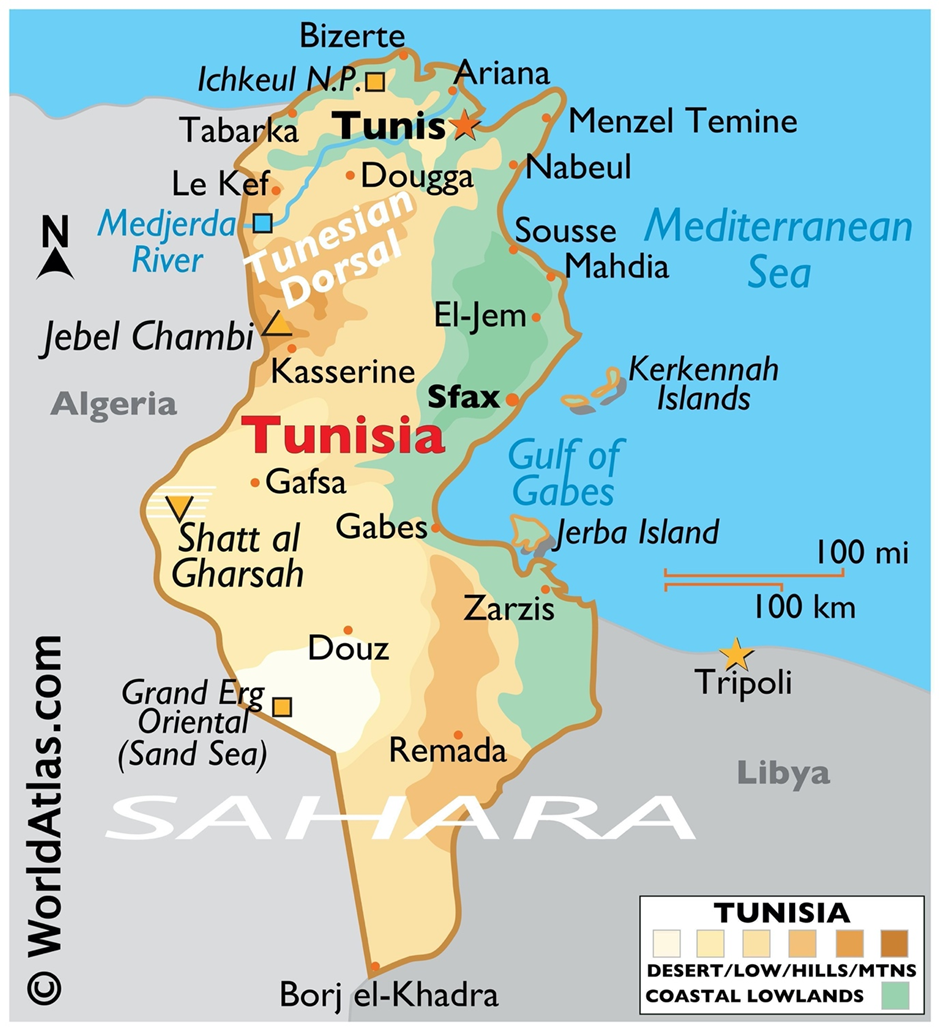
Geography:
- Tunisia is located in North Africa and sits at the crossroads of the Mediterranean Sea and the Sahara Desert.
- It is bordered by Algeria to the west, Libya to the southeast, and the Mediterranean Sea to the north and east.
- Its strategic location has historically made it a hub for trade and cultural exchange, with a coastline stretching over 1,300 kilometres.
- The capital city, Tunis, is a vital economic and political centre.
Economy and Agriculture:
- Agriculture is a cornerstone of Tunisia’s economy, contributing around 10% to its GDP. The country's diverse climate, ranging from Mediterranean in the north to arid in the south, supports a variety of crop productions.
- Tunisia is one of the world's leading producers and exporters of olive oil, a key agricultural asset.
- Cereals such as wheat and barley are staple crops, particularly in the fertile northern regions.
- Fruits and vegetables, including citrus fruits, dates, tomatoes, and peppers, are significant exports, while viticulture has a long-standing tradition in the cooler northern areas, producing wine grapes.
- Alongside agriculture, Tunisia is rich in mineral resources, which play a crucial role in its economy. The country is one of the top global exporters of phosphates, with significant reserves in the Gafsa region, and also produces gypsum, oil, natural gas, and limited quantities of iron ore.
Dal lake
Why in news?
- Uber has launched its first water transport service in India, the Uber Shikara, on Srinagar’s Dal Lake, marking a pioneering move in Asia.
- This service allows users to book traditional shikara rides via the Uber app, combining technology with cultural heritage.
About Dal lake:
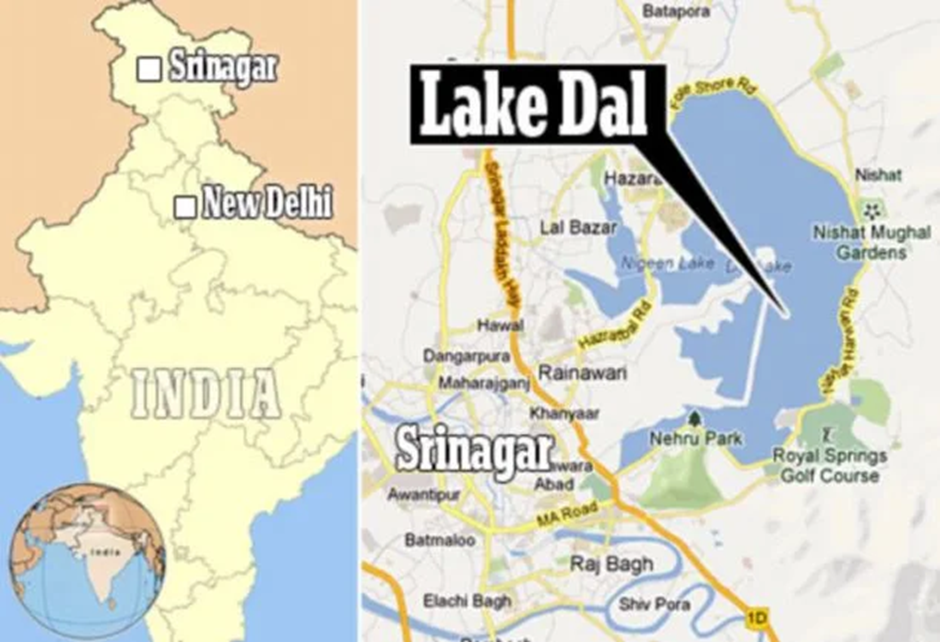
- Dal Lake, located in Srinagar, Jammu and Kashmir, is one of the most prominent tourist destinations in India and is often referred to as ‘Srinagar’s Jewel.’
- It is a freshwater lake that spans approximately 22 square kilometres which is surrounded by the majestic Himalayas.
- The lake is fed by several streams, including the Jhelum River, which drains into it, playing a crucial role in maintaining its water levels and ecosystem.
- Dal Lake is renowned for its scenic beauty and floating gardens, known as ‘Rad’ in Kashmiri, where local farmers grow vegetables and flowers.
- The lake features a network of intricate canals and is home to traditional houseboats and shikaras, which are iconic to the region.
- These shikaras, often ornately decorated, are used for recreational rides, fishing, and transportation, contributing to the local economy and tourism.
- Dal Lake has immense cultural and commercial significance, with vibrant markets like the floating vegetable market, where traders conduct business on boats.
- The lake also supports diverse flora and fauna, making it an important ecological site.
- Its picturesque surroundings, combined with its role in sustaining local livelihoods, make Dal Lake a symbol of Kashmir’s natural beauty and cultural heritage.
Eastern Mediterranean
Why in news?
- Russia's military conducted large-scale drills in the eastern Mediterranean, launching hypersonic Zirkon and Kalibr cruise missiles, along with an Onyx missile from the coast.
- These exercises involved over 1,000 personnel, 10 vessels, and 24 aircraft, with troop presence in the region increased for the operation.
- The drills come amid escalating tensions, as Russia supports Syria's President Bashar al-Assad against Islamist rebels who recently captured Aleppo.
About Eastern Mediterranean:
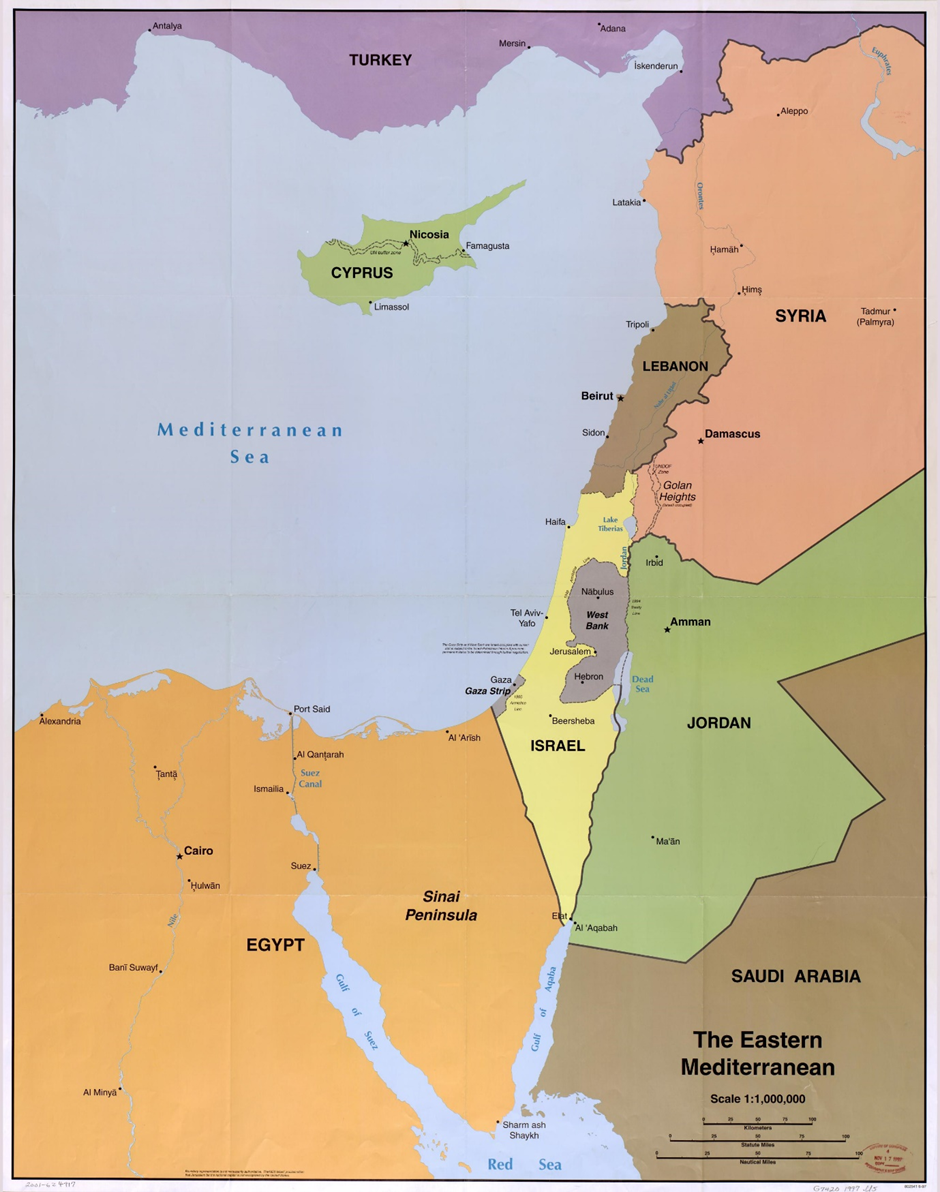
- The Eastern Mediterranean is a historically and geographically significant region, renowned for its rich cultural heritage and strategic importance.
- Historically referred to as the Levant, this region includes modern-day countries like Syria, Lebanon, Israel, Palestine, Jordan, parts of Turkey, and stretches into Egypt.
- The term "Levant" originates from the French word meaning "rising," alluding to the direction of the rising sun in the east and its position relative to Europe.
- Geographically, the Eastern Mediterranean borders the Middle East to the east, and is framed by the Anatolian Peninsula in the north and the Sinai Peninsula in the south.
- This region serves as a crossroads between Europe, Asia, and Africa, facilitating trade, cultural exchange, and the spread of civilizations for millennia.
- Major waterways such as the Suez Canal and the Bosporus Strait enhance its global connectivity, further cementing its importance in geopolitics and commerce.
- The climate of the Eastern Mediterranean is predominantly Mediterranean, characterized by hot, dry summers and mild, wet winters.
- Coastal areas, such as those along Lebanon and Israel, enjoy moderate temperatures due to the influence of the sea, while inland areas experience more continental climate patterns, with hotter summers and colder winters.
- The region’s climatic diversity supports a variety of ecosystems, from olive groves and vineyards to arid deserts.
Ladakh
Why in news?
- In a meeting with the Ministry of Home Affairs, regional leaders from Ladakh secured key agreements, including a 95% job quota for local residents, one-third reservation for women in hill councils, and the inclusion of Urdu and Bhoti as official languages.
- They also proposed demands for statehood, inclusion under the Sixth Schedule, a public service commission for Ladakh, and separate Lok Sabha seats for Leh and Kargil.
- Ladakh residents have been protesting for autonomy, jobs, and constitutional safeguards since its transition to a Union Territory in 2019.
About Ladakh:

- Location:
- Ladakh is located in the northernmost region of India which is a unique and strategically significant Union Territory.
- It shares borders with Pakistan to the west and China to the east, making it of immense geopolitical importance.
- Ladakh is a critical area for India’s security, with several border disputes involving both neighbouring countries. The region encompasses key military bases and high-altitude passes, which are crucial for controlling access to the Siachen Glacier, the Karakoram Range, and the Aksai Chin region.
- Geography:
- Ladakh is renowned for its breath-taking landscapes. The Indus River flows through the region, creating fertile valleys in an otherwise arid environment.
- The region is home to several famous lakes, including Pangong Tso and Tso Moriri, which attract tourists due to their surreal beauty. These lakes are also ecologically significant, supporting a variety of migratory bird species.
- Climate:
- The climate in Ladakh is classified as cold desert.
- The region experiences long, harsh winters with temperatures dropping as low as -30°C, while summers are short and mild.
- Due to its elevation, with most areas above 3,000 meters, the climate is characterized by low rainfall, dry air, and extreme temperature fluctuations.
- Frost and snow are common during the winter months.
- Political status:
- Ladakh became a separate Union Territory (UT) on October 31, 2019, following the abrogation of Article 370 and the bifurcation of the former state of Jammu and Kashmir.
- The Jammu and Kashmir Reorganisation Act, 2019 was passed by the Indian Parliament, which led to the creation of two separate Union Territories: Jammu and Kashmir and Ladakh.
- Ladakh, unlike Jammu and Kashmir, does not have a Legislative Assembly, which means it is directly governed by the Central Government through a Lieutenant Governor.
- The region is governed under the provisions of the Indian Constitution, and the Indian Penal Code (IPC) and Criminal Procedure Code (CrPC) are applicable.
- Laws concerning tribal welfare, such as the Scheduled Tribes and Other Traditional Forest Dwellers (Recognition of Forest Rights) Act, were introduced to protect the tribal communities in Ladakh, who make up more than 90% of the population.
- The status change has led to significant political unrest in the region, with local leaders demanding statehood and greater autonomy, as well as constitutional safeguards for the protection of the region's unique culture and land resources. The move also raised concerns about Ladakh’s fragile ecology, especially with the possibility of industrialization and increased migration due to its open status.
Inner Mongolia
Why in news?
- The Camel 'Naadam' Fair has officially kicked off in Inner Mongolia, celebrating the region's rich cultural heritage and traditions.
- The fair, known for its vibrant festivities, features camel racing, traditional Mongolian performances, and local handicrafts.
- It draws attention to the role of camels in the nomadic lifestyle of Inner Mongolia and promotes the preservation of this unique cultural legacy.
- The event is expected to attract both locals and tourists from around the world.
About Inner Mongolia:
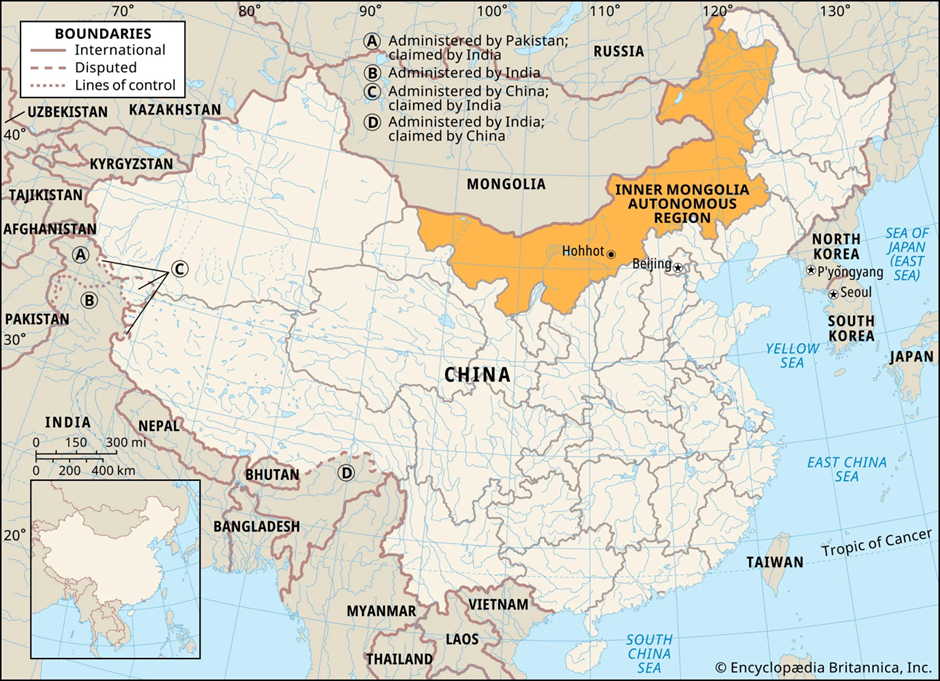
- Inner Mongolia is an autonomous region of China, located in the northern part of the country, bordering Mongolia and Russia.
- It is characterized by vast, arid plains, deserts (including the Gobi Desert), and grasslands that are essential for the region's pastoral economy.
- The Hinggan Mountains and parts of the Tian Shan range also form part of its terrain.
- The region is strategically important due to its proximity to Russia and Mongolia, as well as its resources, such as coal, rare earth minerals, and significant natural reserves that contribute to China's industrial growth.
- Culturally, Inner Mongolia has a rich Mongolian heritage, with a history deeply rooted in nomadic traditions. The Mongolian people form a substantial part of the population, alongside Han Chinese settlers.
- Mongolian is an official language along with Mandarin. Traditional celebrations like Naadam are still widely celebrated.
- The region is home to several species of wildlife, including the wild Bactrian camel, Mongolian gazelle, and snow leopard.
- Livestock, especially sheep and goats, is central to the nomadic pastoral lifestyle that defines much of the traditional culture in the region.
- Additionally, eagle hunting, a practice associated with the Kazakh population, is prevalent in some areas.
Must Check: Best IAS Coaching In Delhi
UPSC Prelims Result 2024 Out: Expected Cut Off & Other Details, UPSC Prelims 2024 Answer with Explanation, Daily Prelims Quiz, Daily Current Affairs, MONTHLY CURRENT AFFAIRS TOTAL (CAT) MAGAZINE, Best IAS Coaching Institute in Karol Bagh, Best IAS Coaching Institute in Delhi, Daily Mains Question Answer Practice, ENSURE IAS UPSC Toppers, UPSC Toppers Marksheet, Previous Year Interview Questions, UPSC Syllabus


